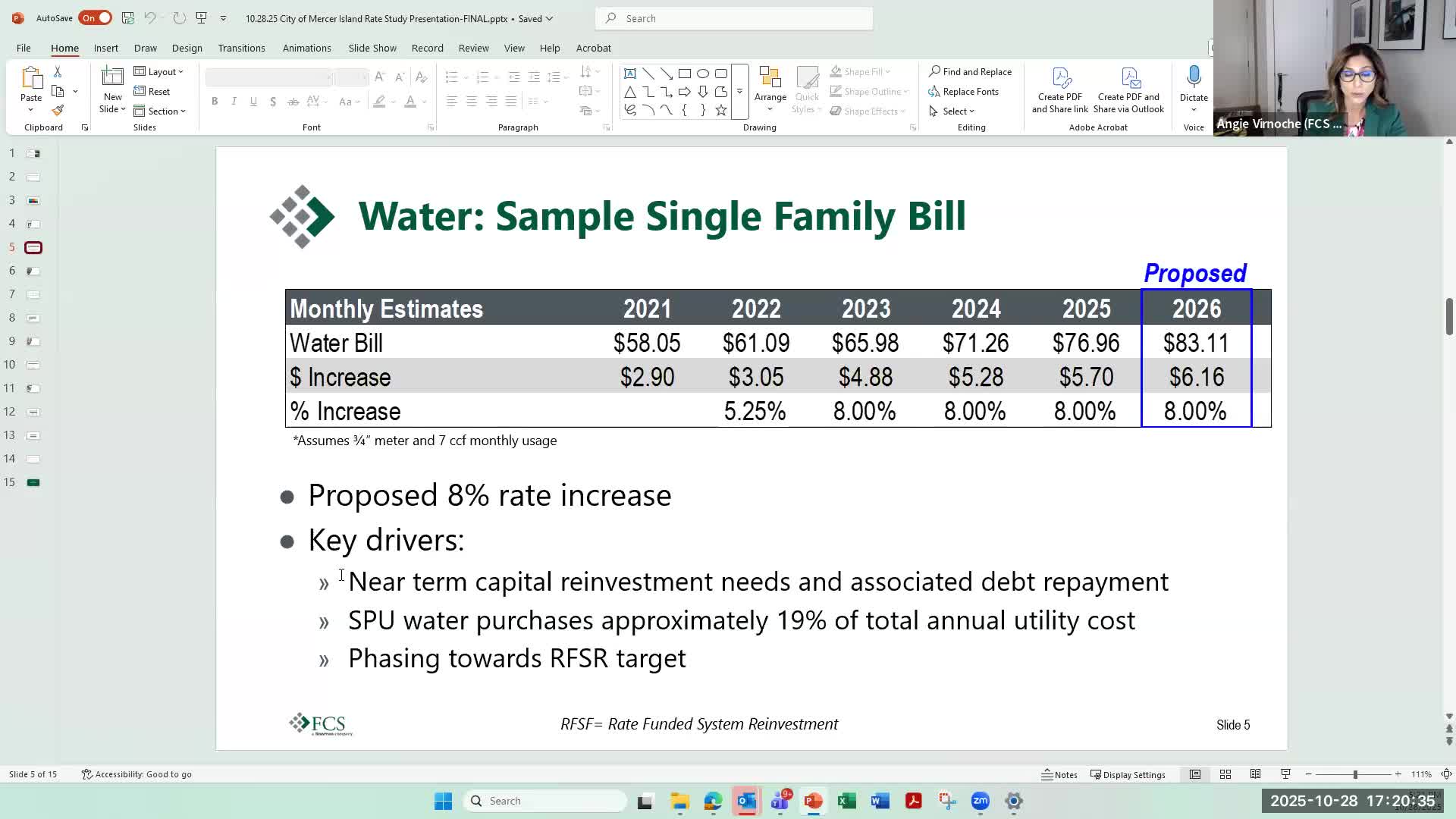Mercer Island utility board backs 8% water rate increase to fund major capital program
November 05, 2025 | Mercer Island, King County, Washington
This article was created by AI summarizing key points discussed. AI makes mistakes, so for full details and context, please refer to the video of the full meeting. Please report any errors so we can fix them. Report an error »

The Mercer Island Utility Board on Oct. 28 voted to recommend an 8% increase in the city’s water rates for fiscal year 2026, arguing the hike is needed to fund extensive capital reinvestment and to cover existing debt service.
The change would raise the typical single‑family monthly bill (assumed 3/4‑inch meter, 700 cubic feet) by about $6.16. Finance Director Matt Mornick and operations staff told the board the recommendation is designed to spread near‑term capital costs and avoid larger single‑year spikes.
Mornick said the city issued roughly $26.6 million in limited‑tax general obligation bonds in 2024 to fund a suite of immediate projects; staff expect to invest most of that money by November 2027 to meet federal tax requirements tied to the issuance. “We ended up taking on that debt, and committing to the next 20 years of paying it down,” Mornick said. He described the approach as intended to “spread out the costs of these significant capital improvements.”
Jason Kennedy, operations, and consultant Angie Sanchez Vernaz of FCS Group emphasized the scope of work driving the rate request: an ongoing program to remove asbestos‑cement (AC) pipe segments from the distribution system (about five miles identified) over a six‑year cycle; pressure‑reducing valve (PRV) station upgrades; reservoir and booster improvements; and upgrades to SCADA controls. Kennedy said the AC‑main program stages design in one year and construction in a following year for separate geographic segments.
Staff reported an increase in emergency repairs in 2025: 16 main breaks recorded to date, with a projection of about 20–21 by year end, a level operations called “abnormally high.” Those failures, staff said, underscore near‑term reliability risks and the need for reinvestment.
Seattle Public Utilities (SPU) purchases represent roughly 19% of the water utility’s annual costs; staff said SPU increases (about 5% in recent forecasts) factor into the city’s overall rate modeling but are an external, pass‑through cost the city does not control. The mid‑biennial study assumes no customer growth for 2026 and incorporates expense inflation tailored by line item.
Action: The board moved to accept staff’s 8% recommendation and voted to forward the rate to the City Council for consideration. The motion carried unanimously at the Oct. 28 meeting.
What’s next: Staff will present the board’s recommendation to the City Council, tentatively scheduled for Dec. 2, 2025. City staff said they will continue capital planning for water projects and share project lists and timelines with the board as work proceeds.
The change would raise the typical single‑family monthly bill (assumed 3/4‑inch meter, 700 cubic feet) by about $6.16. Finance Director Matt Mornick and operations staff told the board the recommendation is designed to spread near‑term capital costs and avoid larger single‑year spikes.
Mornick said the city issued roughly $26.6 million in limited‑tax general obligation bonds in 2024 to fund a suite of immediate projects; staff expect to invest most of that money by November 2027 to meet federal tax requirements tied to the issuance. “We ended up taking on that debt, and committing to the next 20 years of paying it down,” Mornick said. He described the approach as intended to “spread out the costs of these significant capital improvements.”
Jason Kennedy, operations, and consultant Angie Sanchez Vernaz of FCS Group emphasized the scope of work driving the rate request: an ongoing program to remove asbestos‑cement (AC) pipe segments from the distribution system (about five miles identified) over a six‑year cycle; pressure‑reducing valve (PRV) station upgrades; reservoir and booster improvements; and upgrades to SCADA controls. Kennedy said the AC‑main program stages design in one year and construction in a following year for separate geographic segments.
Staff reported an increase in emergency repairs in 2025: 16 main breaks recorded to date, with a projection of about 20–21 by year end, a level operations called “abnormally high.” Those failures, staff said, underscore near‑term reliability risks and the need for reinvestment.
Seattle Public Utilities (SPU) purchases represent roughly 19% of the water utility’s annual costs; staff said SPU increases (about 5% in recent forecasts) factor into the city’s overall rate modeling but are an external, pass‑through cost the city does not control. The mid‑biennial study assumes no customer growth for 2026 and incorporates expense inflation tailored by line item.
Action: The board moved to accept staff’s 8% recommendation and voted to forward the rate to the City Council for consideration. The motion carried unanimously at the Oct. 28 meeting.
What’s next: Staff will present the board’s recommendation to the City Council, tentatively scheduled for Dec. 2, 2025. City staff said they will continue capital planning for water projects and share project lists and timelines with the board as work proceeds.
View full meeting
This article is based on a recent meeting—watch the full video and explore the complete transcript for deeper insights into the discussion.
View full meeting
